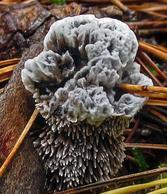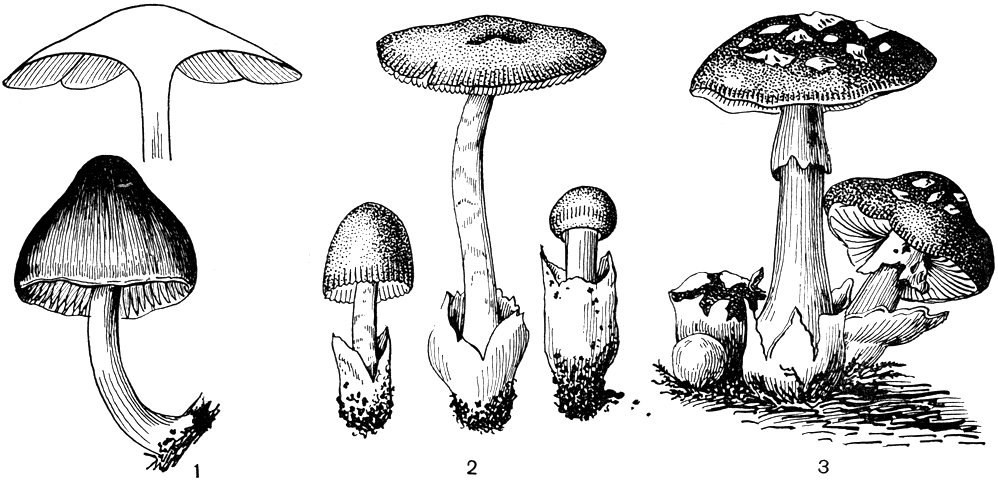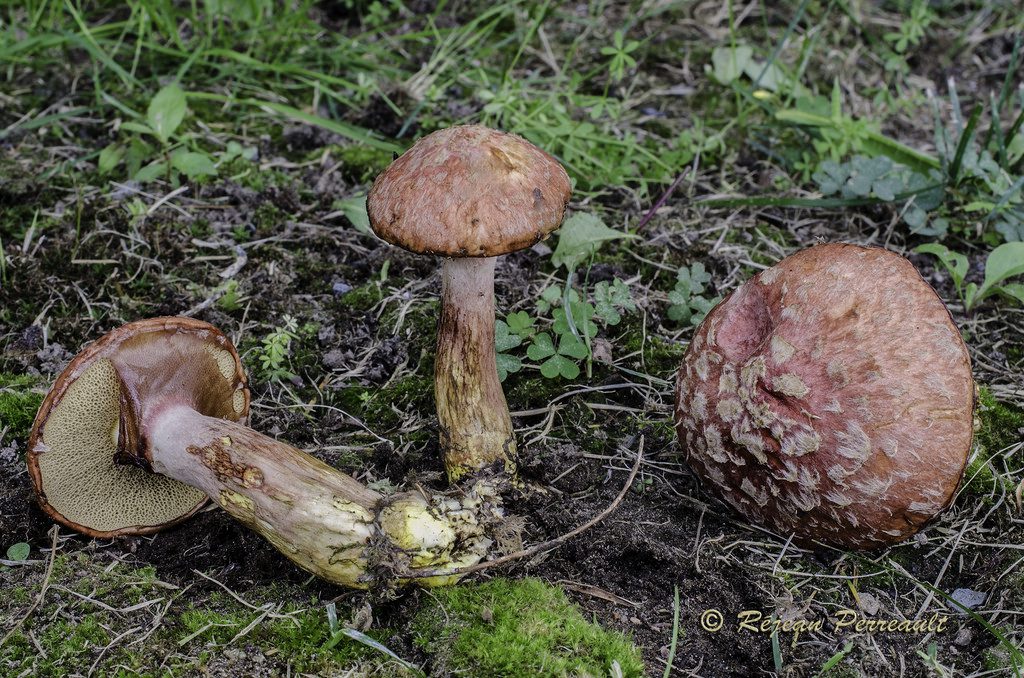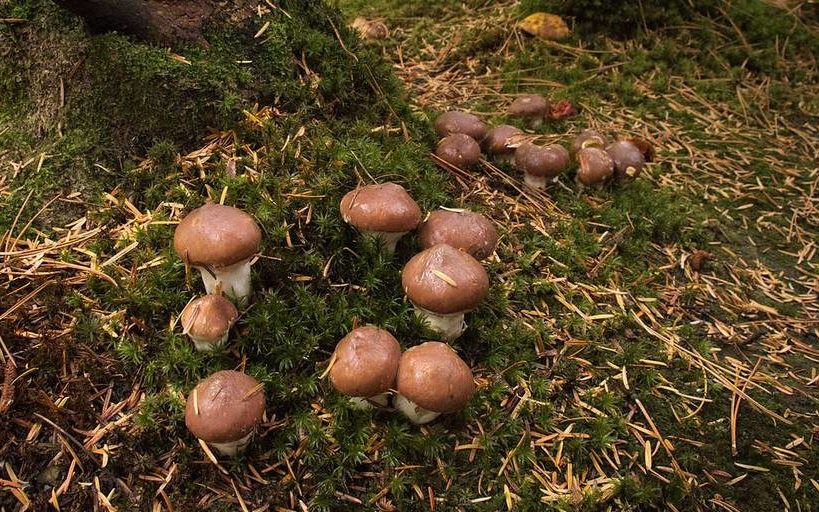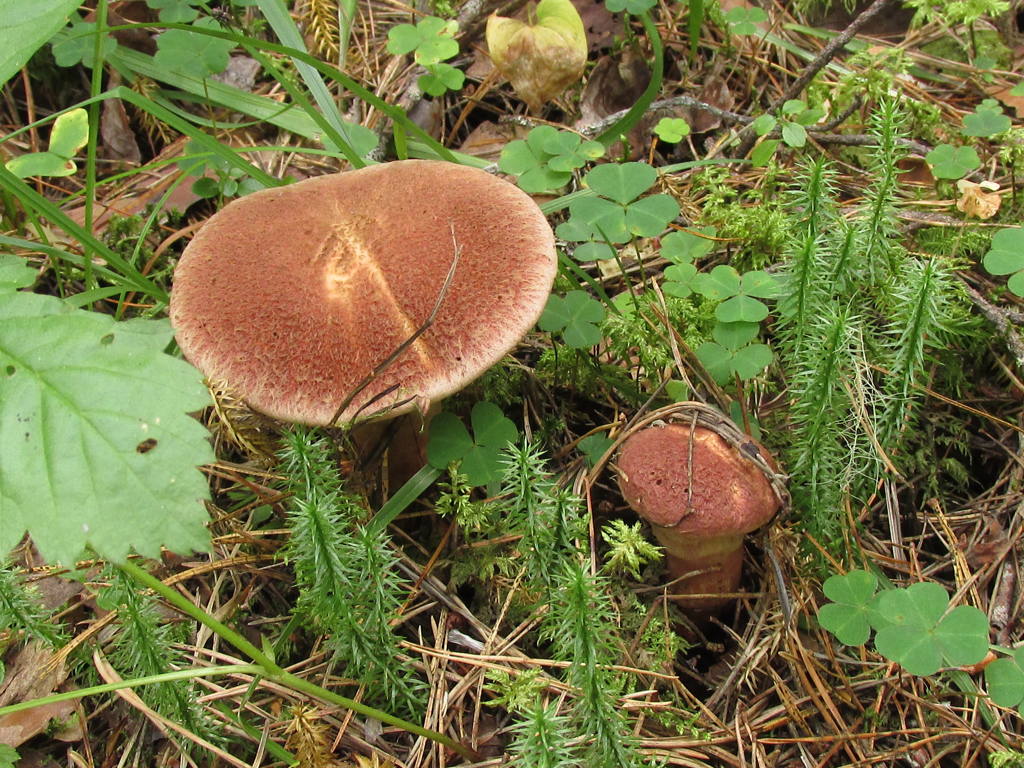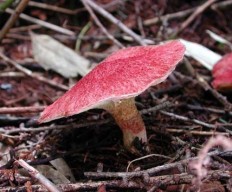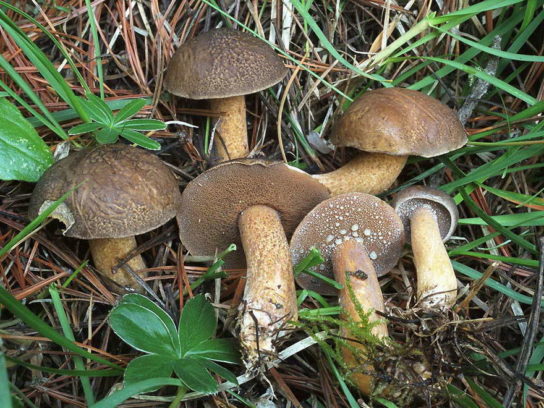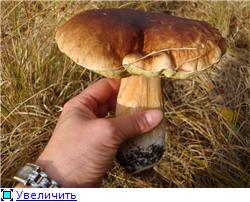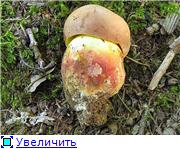Habitat and fruiting period
The fruiting period of the Painted Butter (Suillus spraguei) begins in early summer (June) and ends in September. This type of mushroom prefers to settle on fertile soils, sometimes in the middle of mossy areas. They can often be found in whole mushroom colonies. The commercial species of these mushrooms is widespread in the Far East in Russia and Siberia. Forms mycorrhiza with cedar pine, also growing in Siberia. Rarely, but still found in Germany and some other European countries. In the northeastern part of North America, this fungus is also widespread, forming in those territories mycorrhiza with Weymouth pine.
Oiler remarkable
Notable butter dish - Latin Suillus spectabilis
In another way, such a mushroom is called the magnificent Fuscoboletinus or the elegant Boletinus.
Description
Mushroom cap
Elegant boletinuses have fleshy wide hats: in young mushrooms, the diameter of the cap is 3.5-5 cm, and the shape is usually hemispherical. As the mushroom "headdress" grows, it reaches a diameter of 11-15 cm and looks like a flattened cone.
The hat surface is covered with a sticky skin, easily peeling off the fungus and covered with large grayish or dark brown scales that are conspicuous. The skin is colored wine-red, red-brown or reddish. The scales covering it remain from the veil, under which a tubular layer of young oil is hidden.
The hats are filled with dense yellowish flesh that turns pink and brown when damaged.
The hat bottom consists of a tubular layer growing to the stem, light yellow or yellow in youth, and yellow-brown in old age. If you press on the tubular mass, it turns pink, later brown. The bottoms of young specimens are hidden under a blanket.
Buttercup notable reproduces by smooth, elongated ocher-colored spores contained in ocher spore powder.
Stipe
Fuscoboletinus magnificent builds up a leg of medium length: in young mushrooms, it is 3.5-4 cm, as it grows, it increases to 11 cm.The thickness of the stems is 10-35 mm.
The cylindrical leg is equipped with a jelly-like ring, the inner side of which is sticky. The stems are usually filled with pulp, but there are also empty stems, as well as those that have lost rings.
The leg surface above the rings turns yellow, below and to the base it is covered with dark red scales.
Notable butter dish - Latin Suillus spectabilis
Growing places
Butters of this type prefer moist coniferous forests with swampy acidic soils, in which larch grows. They are collected in the Far Eastern, North American, East Siberian forests.
Fruiting occurs in small groups or as single specimens in July - September.
Despite the not very pleasant taste and a barely noticeable mushroom smell, the Oily can is edible and belongs to the 3rd category of edibility. It is readily pickled, dried and salted.
Boletin marsh - description, where it grows, the toxicity of the mushroom
Mushroom boletin marsh is included in the category of conditionally edible representatives of the kingdom of Mushrooms. Included in the ranking of the ten oldest mushrooms in the modern world. This species lives in deciduous or mixed forests. It can grow with both low and high moisture content. It occurs from mid-summer to mid-autumn. The most common in the forests of the Far East, in the east and west of Siberia, as well as in the Asian part of Eurasia and North America.
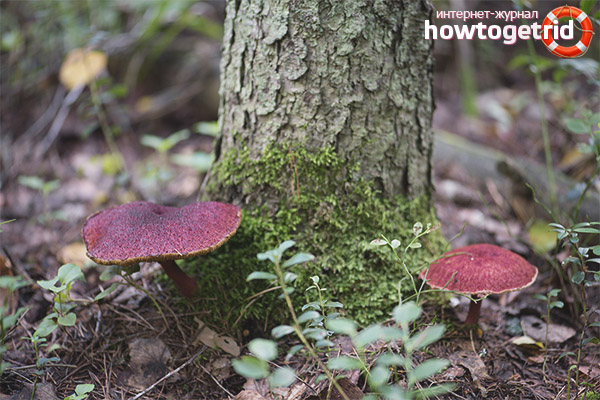
Basic information
The fungus comes from the department Basidiomycetes, Agaricomycetes class, Boletovye order, Oily family.Other names for marsh boletin: marsh sieve, false oiler, ivanchik. The people also call the mullein, the mushroom of the cows, the goat, the lamb, the flywheel.
The appearance of the mushroom
- Hat. The size of the cap in a circle is 5 to 10 centimeters. It has a flat, slightly convex shape, in the center there is a small bump, similar to a pillow. The cap itself is dryish and fleshy. Representatives of the species that have just appeared have a burgundy, ripe cherry or purple color. In the process of growth, the cap is set pale, with a yellow or ocher tint. A tubular layer is present, colored yellowish, later turning brownish. It descends along the leg, and at an early age has a coverlet of a dark pink hue on top. The tubes have radially elongated depressions, their size is up to 4 mm. The color of the spore powder is pale brown.
- Pulp. The pulp of the mushroom is inherent in a yellowish color, sometimes it casts a bluish color. Has a bitter taste. At an early age, boletin does not have a distinct smell; with age, it smells rather unpleasant.
- Leg. The leg of the mushroom can be from 4 to 7 centimeters in height, with a diameter of 1 to 2 centimeters. To the bottom, the leg begins to thicken. The top is yellowish, under the ring with a red color, but not darker than the mushroom cap itself.
Mushroom habitat
Boletin marsh chooses forests with larch and mixed forests for growth. It is found both in areas with low and high humidity. Widely distributed in Siberia, Asia, North America, found in the cultural landscapes of Russia.
Is it possible to eat a mushroom
This type of mushroom is considered conditionally edible. In ancient times, it was eaten in our territories, but today foreign experts consider it unsuitable for food.
The mushroom has a rich, bitter aftertaste, so no one really burns with the desire to eat it. Boletin is used for pickling and pickling, before which it must be well processed.
You can only eat whole, recently collected and mature representatives of the species. Before cooking, they are soaked for three days, periodically the water must be changed to fresh.
To make brine, you need to take half a glass of plain water, 2 tbsp. l. salt, dried carnation flower, dill for one kilogram of mushrooms. Boletins must be put in boiled water, add everything you need, and cook for half an hour, constantly stirring. After dipping the mushrooms on the bottom of the pan, turn off the stove and put the finished mushrooms on a large bowl to cool.
Varieties
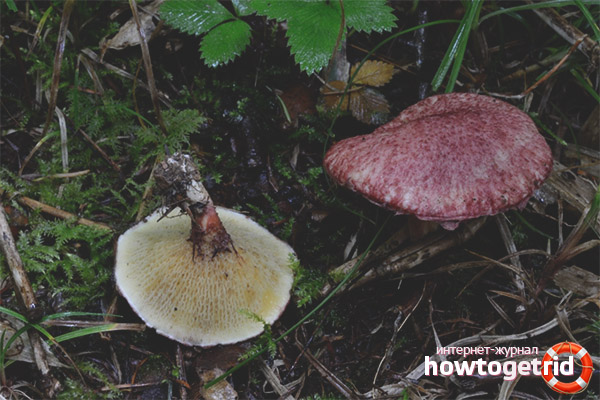 Asian boletin
Asian boletin
Boletin half-leg It looks like a marsh, sometimes called a half-peg flywheel. The hat is thin, up to 17 centimeters in size. At an early age, bell-shaped, later convex with tubercles. There are remnants of the bedspread on the edges of the cap. The color is brown at first, later becomes rusty or yellowish. The surface is dry, not sticky, there are dark-colored scales, there is a light fluff.
At the bottom, the leg has a root form, towards the center it becomes thicker. It can be watery in the rain. There is a sticky ring on top of it. The layer with the tubes is not long, the tubes themselves go down the stem, after which they join the cap. The shade of the tubules is light yellow later changes to brownish-brown, can give off green. Radical arrangement of tubules. Enlarged pores, pointed edges. A spore layer of olive shade, the spores themselves are in the form of ellipses.
Mushroom pulp is arranged in fibers, elastic to the touch, yellowish tint. The taste is acceptable, the aroma is not pronounced. Grows in forests of cedars and larch trees. The mushroom is harvested from late summer to mid-autumn. Boletin half-leg is conditionally edible. It is eaten fresh or dried.
Cooking use
Marsh boletin is an edible mushroom, but because of its bitter taste, it is not particularly popular. Some experts classify it as inedible and even poisonous. Therefore, it is necessary to carefully carry out the heat treatment of this mushroom. It is most often used for pickling and pickling. You need to use fresh, whole, ripe mushrooms.
Be sure to check that they are not wormy. Before processing, the mushroom is soaked for about two to three days, periodically changing the water. For brine, for every kilogram of mushrooms, half a glass of water, 2 tablespoons of salt, cloves, bay leaves, pepper, dill are taken. Mushrooms are placed in boiling salty water and cooked with spices, stirring occasionally, for half an hour. When the mushrooms settle to the bottom and the broth becomes almost transparent, you can turn off the heat and put them on a wide dish to cool them down faster.
After cooling down, we shift the grates into jars or barrels and fill with brine, the amount of which should not be more than a fifth of the weight of the mushrooms. You can eat such mushrooms in a month and a half. They need to be stored in a cool room with constant access to fresh air. The mushrooms should be covered with brine at all times. Salted mushrooms are used in various dishes.
Salad with salted mushrooms and chicken
Products:
- 100 g of salted mushrooms,
- 50 g boiled chicken fillet,
- 150 g boiled potatoes
- 1 pickled cucumber
- 1 tomato,
- boiled egg
- half an onion,
- sour cream or mayonnaise,
- salt,
- sugar,
- spices,
- greens.
Preparation:
Cut all products into equal pieces. Season with sour cream or mayonnaise. Add spices. When serving, sprinkle with finely chopped herbs.
Meat with mushrooms under a cheese crust
Products:
- 0.5 kg of pork or beef,
- large onion,
- clove of garlic,
- 250 gram tin of salted mushrooms,
- 150 g of hard cheese
- Bay leaf,
- salt,
- pepper.
Preparation:
Chop the onion and garlic and fry in sunflower oil. Add the meat cut into small pieces and fry until the meat is browned. Then put salted mushrooms, lavrushka, spices, except for salt in a pan. Add some water and simmer covered over low heat. Shortly before the meat is ready, add salt to taste. When the meat is ready, it needs to be put into a special form, sprinkled with grated cheese and baked in a hot oven for several minutes. Serve hot with boiled or fresh vegetables.
Salad "Fake Olivier"
Products:
- salted mushrooms - 400 g,
- 2 pcs. potatoes,
- onions - 2 pcs.,
- 100 g canned peas
- 100 g mayonnaise
- pepper,
- salt.
Preparation:
Boil the potatoes in their skins, then peel and chop finely. Chop the onion and mushrooms finely. Mix all the ingredients by adding the peas. Season with mayonnaise, salt and pepper. Put in a beautiful dish, garnish with sprigs of greenery and peas.
Characteristics of marsh boletin
Boletin has a tubular structure. Its body consists of a cap and a leg.
Hat
The hat looks like a pillow. It has a flat-convex shape with a tubercle in the middle. Its diameter ranges from 5 to 10 cm. The upper part is dryish, when felt velvety, fleshy. The color depends on age: in young people it is bright red, burgundy or cherry, and in old ones, the cap begins to lose brightness, becomes pale, yellowish.
Tubular hymenophore - the part of the podbot, on which the hymenium is located - the layer where spores are stored. It is located at the bottom of the cap. Diverging in the radial direction, the hymenophore can pass directly into the plates. It has a yellow color that gradually turns brown. The tubular layer sinks noticeably onto the pedicle.
Pulp
The flesh of the podbolnik is painted in a marsh shade, sometimes a barely noticeable blue color is visible. The taste is clearly bitter. The smell of a young boletin is almost imperceptible, but the old one smells rather unpleasant.
Leg
The leg is in the center of the cap, sometimes it can be offset. Its width is about 2 cm, length is 5-7 cm. The leg is velvety in appearance. The upper part is yellow, the base is thickened. On it you can see the remnants of a light red ring.

Types of marsh boletin mushroom
Asian boletin (Boletinus asiaticus)
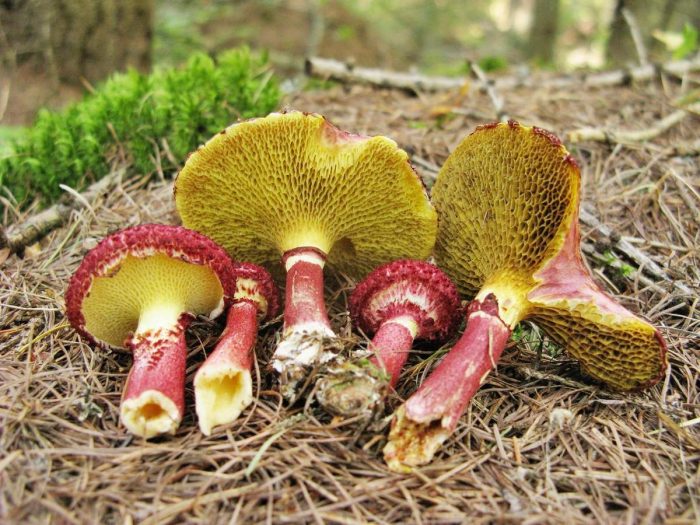
The fungus is widespread in Western and Eastern Siberia, in the Far East (mainly in the Amur Region), as well as in the Southern Urals.It grows mainly among larches; in its cultivated plantings, boletin is often found in Europe (for example, in Finland).
The diameter of the cap of the Asiatic boletin reaches 12 cm. The shape of the cap is convex, the structure is dry, scaly-tomentose, the color is purple-red. The tubular layer descends to the pedicle; the pores are radially elongated, arranged in rows. In a young mushroom, they are yellow, with age they turn into dirty olive. The pulp is yellow, the color does not change on the cut.
The length of the leg of the Asiatic boletus is less than the diameter of the cap. The leg is hollow inside. Its shape is cylindrical, with a ring, below the ring the leg is purple, above it is yellow.
The season for the mushroom runs from August to September.
Boletinus cavipes
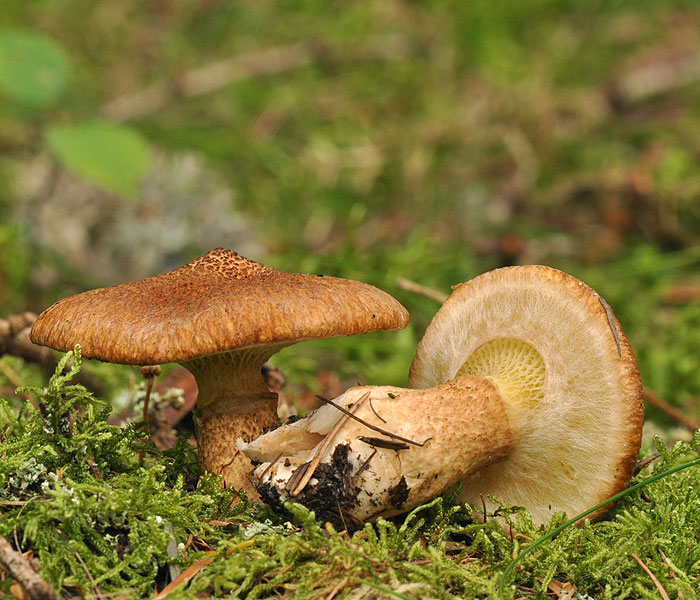
Outwardly, it looks like a flywheel, and is found under the name half-leg flywheel. The boletinus has an elastic, thin cap up to 17 cm in diameter, in a young mushroom it is bell-shaped, in an old one it is convex or flattened with a tuberous surface. A small protruding tubercle is visible on the cap. On the edge, the cap is lobed, with scraps of bedspreads. The color changes with age from brown to rusty red and yellow. The cap is dry, not sticky, covered with dark scales of a fibrous structure. There is a thin fluff on the skin.
The leg is tapered at the base, thickened in the center, hollow. It becomes watery in rainy weather. There is an adhesive ring on the top of the leg. The tubules are short, go down the pedicle and are tightly attached to the cap. The color of the tubular layer is pale yellow, gradually becoming brownish or greenish. The tubes are located radially. The pores are wide, the edges are sharp. Spores of olive-buffy color, ellipsoid-fusiform.
The pulp of the mushroom is fibrous, elastic, yellow. The taste is pleasant, the smell is weak.
Boletin grows in cedar and deciduous forests, in August-October.
The mushroom is conditionally edible, eaten fresh or dried.
Larch flywheel (Psiloboletinus lariceti)
Synonyms:
- Boletinus lariceti
- Larch boletin

Psiloboletinus is a genus of fungi of the Suillaceae family. It is a monotypic genus containing one species, Psiloboletinus lariceti. The species was first described by the mycologist Rolf Singer in 1938 as Phylloporus. Alexander H. Smith disagreed with Singer's general concept, concluding: “Regardless of which arrangement of the type species Psiloboletinus is ultimately made, it is clear that there are no clearly distinguishable characters by which the genus could be recognized. based on Singer's descriptions ”.
"Larch" - from the word "larch" (a genus of woody plants of the pine family, one of the most common species of conifers), and not from the word "deciduous" (Deciduous forest - a forest consisting of deciduous trees and shrubs).
Description
Hat: 8-16 cm in diameter; under favorable conditions, specimens with caps of about 20 centimeters are possible. In youth it is convex, with a strongly tucked inward edge, then flat-convex; in very adult mushrooms, the edge of the cap is not tucked up, it may be slightly wavy or lobed. Dry, felted or tomentose-scaly, velvety to the touch. Brownish, ocher-brown, dirty brown. Flesh in the cap: dense (not loose), soft, up to 3-4 cm thick. Light yellowish, light buffy, very pale, almost white. Turns blue at a break or cut.

Hymenophore: tubular. The tubules are large, wide, with thickened side walls, and therefore visually form a semblance of plates. They run down strongly on the leg, where they become elongated, which is why their visual resemblance to the plates increases. The hymenophore is yellow, light in youth, then yellowish-brownish. When damaged, even minor, it turns blue, then turns brown.
Spores: 10-12X4 microns, cylindrical, fusiform, brown-yellow with drops.
Leg: 6-9 centimeters high and 2-4 cm thick, central, can be thickened at the bottom or in the middle, velvety.In the upper part it is light, in the color of the hymenophore, yellowish-brownish, below it is darker: brownish, brownish, dark brown. Turns blue when pressed. Whole, sometimes with a cavity. The flesh of the leg: dense, brownish, blue.
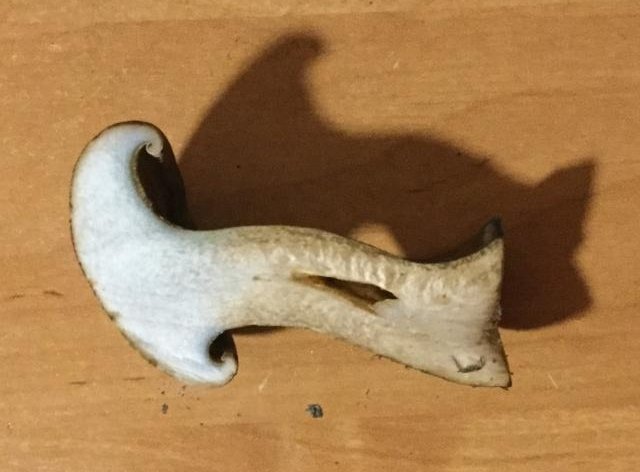
Ring, bedspread, volva: none.
Taste and smell: mild mushroom.
Ecology
It grows only in the presence of larch: in larch forests and mixed forests with the presence of birch, aspen, under larch.
Season and distribution
The peak of fruiting occurs in August-September. It is well known only on the territory of Russia, found in Western and Eastern Siberia, Amur region, Khabarovsk Territory, in the Far East, especially often and abundantly bears fruit on Sakhalin, where it is called "Larch moss" or simply "moss".
Edibility
The mushroom is edible, there is no data on poisoning. It is used for making soups, salads, main courses. Suitable for pickling.
Similar species
A slender pig in some growth stages can be mistaken for a larch flywheel. You should carefully look at the hymenophore: in the pig it is lamellar, in young specimens the plates are wavy, so that at a cursory glance they can be mistaken for large tubes
An important difference: the pig does not turn blue, but turns brown when tissue is damaged
Gyrodons are quite similar to Psiloboletinus lariceti, you should pay attention to the ecology (type of forest). Goat, it differs in the color of the flesh in the damaged areas, its flesh does not turn blue, but turns red
The goat, differs in the color of the flesh in the damaged areas, its flesh does not turn blue, but turns red.
Healing properties
Purposeful studies were carried out, there are works on the thrombolytic properties of enzymes of basidal fungi (Botanical Institute named after V. L. Komarov, Russian Academy of Sciences, St. Petersburg, Russia), where there is a high fibrinolytic activity of enzymes isolated from Psiloboletinus lariceti. However, it is too early to talk about widespread use in pharmacology.
Note: The photographs from the questions in "Recognition" are used as illustrations in this article. If you have good photos of this mushroom, please share.
External description of the mushroom
The hat of the painted oil can has a diameter of 3 to 15 (and in exceptional cases - up to 18) cm. Along its edges you can often see the remnants of a private bedspread in the form of flakes. The shape of the cap can be wide, conical, or cushion-shaped (in the middle, in this case, there is a noticeable tubercle). There is also a flat-cushion-shaped cap in the painted oiler, with the edges wrapped on top. The shade of the cap changes in different weather, becoming brighter and darker with high levels of humidity outside. As it ripens and ages, the cap of the mushroom turns yellow, sometimes acquiring a yellow-brown hue. Color change also occurs when the fungus is affected by insects. At a young age, the color the caps of the painted oiler can be red, brick red, burgundy brown, wine red. The surface of the cap is covered with small scales of a gray-brown or brown hue, through the layer of which the surface of the mushroom cap itself can be seen.
The length of the leg is 4-12 cm, and the thickness is 1.5-2.5 cm. Sometimes it can thicken up to 5 cm at the base. In the supra-annular zone of the fungus, there are many tubules descending along the stem and forming a mesh. The color of the leg is yellow, and at the base it is rich ocher. The entire surface of the leg is covered with red-brown scales, gradually drying out.
The spore tubes of the fungus are quite large, their width parameters are 2-3 mm. By their structure, they are elongated radially, running down onto the leg in uneven lines. The color of the tubes can be rich ocher, bright yellow, ocher-brown, brownish immediately after pressing, pressing on the surface or damage to the structural fibers of the fungus. It is very difficult to separate them from the cap, since the tubes seem to have grown to it.
The pulp of the mushroom is characterized by a yellow color, high density. On the cut, the pulp turns red, often acquires a reddish-brown tint.The taste and aroma of this type of mushroom is soft, pleasant and mushroom. The private bedspread is characterized by a pinkish-white or white color, it has a small thickness and fluff. In ripe mushrooms, a gray or white ring forms in place of a private bedspread, which darkens and gradually dries up.
The spore powder of mushrooms has a clay, olive-brown or yellow-brown hue.
Definitioner
- Basidia (Basidia)
-
Lat. Basidia. A specialized structure of sexual reproduction in fungi, inherent only in Basidiomycetes. Basidia are terminal (end) elements of hyphae of various shapes and sizes, on which spores develop exogenously (outside).
Basidia are diverse in structure and method of attachment to hyphae.
According to the position relative to the axis of the hypha, to which they are attached, three types of basidia are distinguished:
Apical basidia are formed from the terminal cell of the hypha and are located parallel to its axis.
Pleurobasidia are formed from lateral processes and are located perpendicular to the axis of the hypha, which continues to grow and can form new processes with basidia.
Subasidia are formed from a lateral process, turned perpendicular to the axis of the hypha, which, after the formation of one basidium, stops its growth.
Based on morphology:
Holobasidia - unicellular basidia, not divided by septa (see Fig. A, D.).
Phragmobasidia are divided by transverse or vertical septa, usually into four cells (see Fig. B, C).
By type of development:
Heterobasidia consists of two parts - hypobasidia and epibasidia developing from it, with or without partitions (see Fig. C, B) (see Fig. D).
Homobasidia is not divided into hypo- and epibasidia and in all cases is considered holobasidia (Fig. A).
Basidia is the place of karyogamy, meiosis and the formation of basidiospores. Homobasidia, as a rule, is not functionally divided, and meiosis follows karyogamy in it. However, basidia can be divided into probasidia - the site of karyogamy and metabasidia - the site of meiosis. Probasidium is often a dormant spore, for example in rust fungi. In such cases, probazidia grows with metabasidia, in which meiosis occurs and on which basidiospores are formed (see Fig. E).

See Karyogamy, Meiosis, Gifa.
- Pileipellis
-
Lat. Pileipellis, skin - differentiated surface layer of the cap of agaricoid basidiomycetes. The structure of the skin in most cases differs from the inner flesh of the cap and may have a different structure. The structural features of pileipellis are often used as diagnostic features in descriptions of fungi species.
According to their structure, they are divided into four main types: cutis, trichoderma, hymeniderma and epithelium.
See Agaricoid fungi, Basidiomycete, Cutis, Trichoderma, Gimeniderm, Epithelium.
Similar types and differences from them
The described boletus resembles the following edible counterparts:
- Clinton's butter dish. Although it grows under larch trees, its cap is colored only reddish-brown and has no scales.
- Sprague's Butter Can. A mushroom growing in the taiga under cedars or Siberian cedar pines. Unlike the notable Oiler, its counterpart has a more imposing appearance and a hat with dry skin. Its cap is densely covered with more convex and smaller scales, which have a grayish-pink, pinkish-brown or brick color.
- Trentian butter dish. A rare species that prefers deciduous trees in moist conifers. Unlike its remarkable counterpart, the Trentian mushroom does not turn yellow, even in the smallest way. His hat is completely covered with tiny felt-like scales, and the flesh is painted in a pale pink color.

